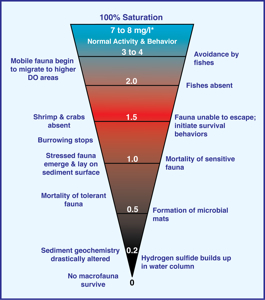Impacts
 Compared to land animals, marine organisms face a much greater challenge in extracting oxygen from the environment to fuel their metabolism. That's because water, depending on its temperature and salinity, contains 20-40 times less oxygen by volume than air (and saltwater holds somewhat less oxygen than freshwater). Oxygen also diffuses about 10,000 times more slowly through water than through air. Thus, even small decreases in dissolved oxygen can significantly impact marine animals.
Compared to land animals, marine organisms face a much greater challenge in extracting oxygen from the environment to fuel their metabolism. That's because water, depending on its temperature and salinity, contains 20-40 times less oxygen by volume than air (and saltwater holds somewhat less oxygen than freshwater). Oxygen also diffuses about 10,000 times more slowly through water than through air. Thus, even small decreases in dissolved oxygen can significantly impact marine animals.
The concentration of dissolved oxygen in ocean water is typically between 7 and 8 milligrams per liter (mg/L). If concentrations fall below 4 mg/L, organisms will begin to react, with mobile forms either avoiding or migrating out of the area. Waters with less than 0.2 mg/L of dissolved oxygen are called anoxic and are unable to support most forms of life. Waters with no measurable dissolved oxygen are called hypoxic.
Hypoxia tends to be overlooked until it starts to affect organisms that people eat. A possible indicator of hypoxia's adverse effects on an economically important finfish species in Chesapeake Bay is the purported link between oxygen-poor bottom waters and a chronic outbreak of a bacterial disease among striped bass. Several Bay researchers, including VIMS fish pathologist Wolfgang Vogelbein, hypothesize that the high prevalence of mycobacteriosis among Bay stripers (>75%) is due to the stress they encounter when development of the Bay's summertime dead zone forces them from the cooler bottom waters they prefer into warmer waters near the Bay surface. Research also links dead zones with stresses on the bottom-dwelling communities of Chesapeake Bay.
A more fundamental effect of hypoxia is the loss of energy from the Bay’s food chain. By precluding or stunting the growth of bottom-dwellers such as clams and worms, hypoxia robs their predators of an important source of nutrition. VIMS scientists estimate that Chesapeake Bay loses about 10,000 metric tons of organic carbon to hypoxia each year, 5% of the Bay’s total production of food energy. The Baltic Sea has lost 30% of its food energy—a condition that has contributed to a significant decline in its fisheries yields.
